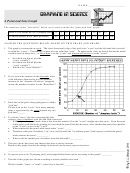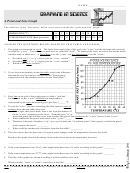A Point And Line Graph Page 2
ADVERTISEMENT
NAME: __________________________
A Point and Line Graph
The numbers in the "data table" below were used to make the "point and line" graph.
TEMPERATURE ( o C)
0
5
10
15
20
25
30
35
40
AVERAGE HEART RATE (Beats per minute)
20
22
30
53
70
85
125
133
139
ANSWER THE QUESTIONS BELOW, BASED ON THIS TABLE AND GRAPH:
1. This graph is constructed on a grid. The lower (horizontal) edge of this grid is the "x-axis" and the left-hand side (vertical)
is called the "y-axis". The numbers on each axis are called the "scale". To make up the scale, we had to first decide which
variable went on which axis; i.e. Heart Rate is on the "y-axis" and Air Temperature is on the "x-axis".
a.
On which axis ("x" or "y") did we plot the "cause variable"? __
b.
On which axis ("x" or "y") did we plot the "result variable"? __
c.
Which is the "cause variable"?
___________________________________________________
2. If you look at the numbers in the data table, what is the difference
between the way the numbers increase for the "Temperature"
compared to how the numbers increase for the "Heart Rate"?
_______________________________________________________
_______________________________________________________
_______________________________________________________
3. Each line on the grid of the graph paper is called a "grid line".
For the scale on the "x-axis", difference in temperature is
represented by the space between any two grid lines?______ o C.
4. To plot the "curve" (the line connecting the little squares), pairs of
numbers from the data table were used.
•
With a light, thin pencil mark, draw a line from the number 10
on the "x-axis" straight up to the curve. From the point "A" at
which the pencil line hits the curve, draw another thin pencil line (parallel to the "x-axis") across to the "y-axis".
a.
What number did the pencil mark reach at the "y-axis". _____.
b.
Therefore, what pair of numbers ("x/y") was used to make the "co-ordinate point" (little square) at which the pencil
marks meet at the curve? __________.
c.
What would be another pair of numbers from the data table? __________.
5. The curve shows how the heart rate of a typical snake changes as the air temperature increases (by itself).
Based on this graph, describe the change in the snakes' heart rate as the temperature increases.
___________________________________________________________________________________________________
6. If the room temperature was 25 o C, what might be the heart rate of a snake, according to this graph? _________
7. If the room temperature was 27 o C, what might be the heart rate of a snake, according to this graph? _________
8. The title of this graph was chosen according to which variables were used.
Which variable, "cause" or "result", comes first in the title? _______________
Note: The numbers in the graph were made up. Remember, you are not allowed to purposely change the body temperature of a Vertebrate.
ADVERTISEMENT
0 votes
Related Articles
Related forms
Related Categories
Parent category: Miscellaneous
 1
1 2
2








